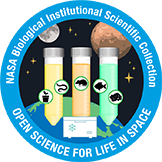
NASA Biological Institutional Scientific Collection (NBISC)
at Ames Research Center
NBISC is a biorepository of non-human samples collected from NASA-funded spaceflight investigations and correlative ground studies. The purpose of NBISC is to receive, store, document, preserve, and make the collection available to the scientific community.
Since 1995, NBISC has fostered gravitational biology research by providing access to these rare and unique samples to maximize the scientific return. Samples not utilized by primary investigations are preserved and made available through an open-science approach. Historically, these samples have been used in a wide range of analyses, including histology, genomics, and transcriptomics.

What Biospecimens and Materials are available?
Biological tissues are predominantly from mice and rats, with some available from quail. Tissues are from musculoskeletal, neurosensory, reproductive, respiratory, circulatory, and digestive systems and stored at -80°C, -20°C, +4°C, or ambient, depending on the preservation method. SMCC materials collected from the air, surfaces, and water from spaceflight missions and related ground studies are similarly stored to maintain viability. Detailed metadata is available for all tissues and materials.
NBISC announces the arrival of the NASA Space Microbial Culture Collection!
The NASA SMCC is a repository for collections of space microbes originated by NASA scientists and research PIs and offers digital (genomic, phenotypic, and rich metadata) and physical formats (the isolates themselves) of space microbes which can be requested for non-commercial research purposes.
The NASA SMCC strives to offer a trustworthy, dependable and protect service for storage of important microbial collections. Collections entrusted to the care of the SMCC will have a dedicated and knowledgeable microbiologist monitoring and maintaining all isolates. comes in. Each collection is protected with backup power systems in a lab dedicated to the task. Collections will be protected from contamination in an environment set up specifically to be a sterile micro lab with systems for sanitization and decontamination.
Collections will be housed in controlled environments that are routinely audited for quality. Systems involving cataloging data and physical locations as well as regular confirmatory sequencing to verify identity and check for contamination will be implemented. Collections will be secure in responsive environments, the main “vaults” of lyophilized samples can respond to external changes and drop internal humidity.
SMCC has set up ultra-low temperature storage and will keep stocks of isolates in chest freezers on backup power. Locally, lyophilized samples will be maintained in environmentally controlled vaults that are easily moved and responsive in the event of changing external conditions.
To find out more about submitting a gravitational or space-associated microorganismal collection to the NASA SMCC or requesting isolates please contact mo.kaze@nasa.gov for more information.
Who can request Biospecimens and Materials?
Samples are available for request by all researchers, including those outside the United States. While they are most often requested by researchers in the space biosciences field, they may also be of interest to those involved in general, interdisciplinary research and those studying disease processes, such as muscle atrophy and bone demineralization. Educators from middle and high schools, and community colleges are encouraged to request samples for in-classroom instruction or specialized student projects.
How do I request Biospecimens and Materials?
Samples are searchable through the NASA Life Sciences Portal To request, the researcher must first submit an online Request Form. Once the request is received, a confirmation reply will be sent to the email address provided. When availability of the samples is confirmed, the requestor will be sent instructions for preparing a 2-3 page proposal.
How do samples get awarded?
Proposals are assessed based on merit, taking into account the significance, experimental design, innovation of the proposed research, the requestor's expertise and contribution to the field, and the scientific environment in which the research will take place. Requestors are expected to be fully funded to analyze the samples. If samples are awarded, a Data Submission Agreement (DSA) is required and will be prepared by NBISC. Samples are shipped to the requestor upon receipt of the signed DSA. Acceptance of the samples commits the requestor to provide results of the study (raw and analyzed data) and a final report. Any publications resulting from the study must be appropriately attributed to NASA.
Are there funding opportunities?
NASA also solicits proposals for research using NBISC samples. On these occasions, the Biological and Physical Sciences division issues a call for proposals, reviews submitted proposals for scientific merit, technical feasibility, and program relevance, and makes selections. Current NASA funding opportunities can be found on NASA's Solicitation and Proposal Integrated Review and Evaluation System (NSPIRES) website .
How can I learn more about the knowledge gaps and literature background regarding the field of space biosciences?
Translational Cell and Animal Research in Space, Ames Research Center, 1965-2011 summarizes 46 years of cell and animal research in space funded investigations by the Space Biology Program. This publication includes one-page experiment descriptions organized by science discipline. Each experiment description page provides information on the investigator team, research subjects, ground-based controls, flight hardware, and select publications.
In 2011, the National Research Council published the most recent 'Decadal Survey': Recapturing a Future for Space Exploration Life and Physical Sciences Research for a New Era . The Decadal Survey was commissioned by the U.S. Congress to survey the extramural scientific community on the kinds of life and physical sciences research NASA should be undertaking to enable space exploration, both in Low Earth Orbit and beyond to the Moon and Mars. It summarizes and offers recommendations for needed human, animal, cell, microbial, plant, and other types of research.
Ongoing studies carried out by NASA's Human Research Program (HRP) generate a constant stream of exciting new data, findings, and breakthroughs. Periodically, HRP Evidence Reports are published as evidence-based reviews of the current state of knowledge from research and operations for each of the identified human health and performance risks.
Contact
Contact the NBISC at ARC-DL-NBISC@mail.nasa.gov





